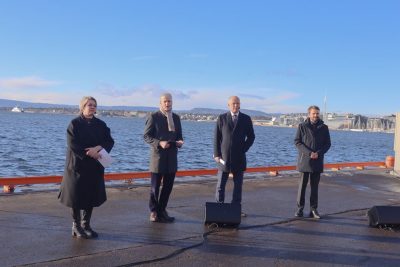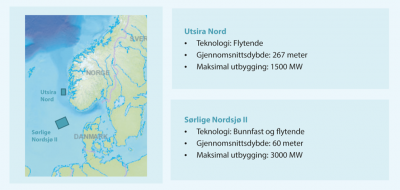Criticism is flying once again after the Norwegian government finally launched development plans this week for two offshore wind energy fields in the southern portion of the North Sea. Neither may be profitable, with critics calling them “a lost opportunity” and a “belly-flop” because of compromises struck within the government coalition.

Trade Minister Jan Christian Vestre from the Labour Party did his best to build enthusiasm around the wind energy project, likening it to plans more than 50 years ago for Norway’s first offshore oil platforms and even pioneering hydroelectric projects decades before that.
“With the (offshore) competence we have and access to pure wind power, we have huge possibilities to become a green industrial giant,” Vestre claimed at an outdoor press briefing on an appropriately windy day along the Oslo Fjord this week.
Two areas of the North Sea, Utsira Nord west of Haugesund and Sørlige Nordsjø II, midway between Norway and Denmark will be divided into sections and auctioned off to developers of offshore wind power (called havvind in Norwegian). Utsira Nord will be opened up for portable turbine wind production of up to 1500MW (megawatts). Sørlige Nordsjø II will be set aside for turbines with technology making them both portable and fastened to the seafloor, and generating up to 3000MW but only half that in a first phase. Operating licenses will be auctioned off to whichever power producers pay the most, or demand the least subsidy from the state.
Power produced on the offshore fields will be sent by cable back to the Norwegian mainland. “Norway needs more power supplies,” stated Labour’s Oil and Energy Minister Marte Mjøs Persen during the government’s long-awaited announcement of offshore wind projects. With Norwegian industry, the country’s transport sector and even offshore oil platforms due to be electrified (in order to reduce carbon emissions and meet climate goals), the new offshore wind power fields “will contribute towards creating necessary and sought-after renewable energy for the Norwegian market,” Persen added. Power generated from wind at the Utsira and Sørlige Nordsjø fields may boost Norwegian power production by 10 percent or more, and provide enough electricity for more than 1.4 million homes.
‘Unfortunate’
Market reception, along with that from opposition parties in Parliament and media commentators, was far from enthusiastic, however. Industry officials have complained that development of wind energy fields designated by the former government in 2020 is long-overdue and now disappointingly scaled-down. The one-way cables back to the mainland also risk making the projects unprofitable. Power producers want to be able to sell their power abroad, or at least have so-called “hybrid cables” that can send power both back to Norway or abroad. Even Norway’s biggest trade union federation, LO, was disappointed that use of hybrid cables is not included in the first phase of development because that can slow the projects down.
Norway’s national employers’ organization, NHO, was also disappointed. “It’s unfortunate that the government is starting out with solutions that will demand public financial support instead of choosing the commercial solutions,” stated NHO leader Ole Erik Almlid. “A unified offshore wind industry has been clear that only a hybrid-cable network will secure development on a scale without need for subsidies.” He hopes that by the time the fields’ licensing regime is ready, hybrid cables will be included.

It’s the Center Party, Labour’s government coalition partner, that opposes hybrid cables and especially cables that only send power abroad. Center is most keen on lowering Norway’s record-high electricity rates at present, and blames the high rates on the export of Norwegian electricity abroad. It thus forced through the compromise that resulted in cables on the new North Sea projects only back to Norway. Opposition parties in Parliament pounced immediately.
“Disagreement within the government means investment in offshore wind energy is being scaled down and postponed,” claimed MP Nikolai Astrup of the Conservative Party, a former government minister himself. “This is unfortunately a belly-flop for the government’s industrial policy.”
Astrup called the conditions attached to the new wind energy fields “a sensationally weak solution from the pro-industry Labour Party, and a lost opportunity for the offshore supply industry along the entire coast. This must be extremely embarrassing for Labour, which had been promising a new industrial adventure within offshore wind for many months.”
Defends attempt to move forward
Government Labour’s Trade Minister Vestre dismissed the criticism, retorting via newspaper Dagens Næringsliv (DN) that the former Conservatives-led government in which Astrup served didn’t make much progress on offshore wind projects either. “At least we’re building them now,” Vestre said, adding that the projects should be up and running by the end of the decade: “His (Astrup’s government’s unrealized) plan wouldn’t have come on line until 2030 or 2031.”
Vestre is aware that market players, however, want hybrid cables to make offshore wind projects profitable. Now the government is calling for yet another study into how such cables to allow exports would affect the power system. The government is also suggesting subsidies to offset higher costs. Other political critics still fear the projects as now unveiled won’t be attractive.
“This is not an historic investment in offshore wind energy, rather they’re stepping on the brakes,” claimed MP Ola Elvestuen of the Liberal Party. “For ordinary folks, it means less energy will be produced at a higher price.” Not even the Reds or the Socialist Left Party, on which the Labour-Center government relies for a majority in Parliament, were impressed.
Vedum’s ‘political choice’
Center Party leader Trygve Slagsvold Vedum, who also serves as finance minister, dodged questions as to whether hybrid cables may ultimately be allowed if bidders demand them. “We don’t want electricity rates to go up, but down,” said Vedum, who’s convinced that exporting electricity abroad raises prices in Norway. “That’s a political choice.” He couldn’t explain how electricity rates will go down if offshore wind production won’t be profitable, other than claiming that it will “improve the power balance.”
Labour, meanwhile, seems to have given in to Center’s demand to drop hybrid cables simply to finally start development of offshore wind on the Norwegian Continental Shelf. Norway has been slower than many other European countries to launch offshore wind, despite some smaller projects designed to electrify offshore oil and gas platforms
Labour leader and Prime Minister Jonas Gahr Støre insists Labour “is fully behind” the “solution” launched this week. “We’ve seen over the past few months (of record-high electricity bills) that we need renewable energy,” Støre told DN. “This is a win-win solution.”
newsinenglish.no/Nina Berglund

